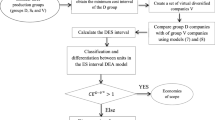Abstract
In the existing DEA models, we have a centralized decision maker (DM) who supervises all the operating units. In this paper, we solve a problem in which the centralized DM encounters limited or constant resources for total inputs or total outputs. We establish a DEA target model that solves and deals with such a situation. In our model, we consider the decrease of total input consumption and the increase of total output production; however, in the existing DEA models, total output production is guaranteed not to decrease. Considering the importance of imprecise data in organizations, we define our model so as to deal with interval and ordinal data. A numerical illustration is provided to show the application of our model and the advantages of our approach over the previous one.
Similar content being viewed by others
Explore related subjects
Discover the latest articles and news from researchers in related subjects, suggested using machine learning.References
Athanassopoulos AD (1995) Goal programming and data envelopment analysis (GoDEA) models for multi-level multi-unit organizations: an application to Greek local authorities. Eur J Oper Res 87(3): 535–550
Athanassopoulos AD (1996) Assessing the comparative spatial disadvantage of European regions using non-radial data envelopment analysis models. Eur J Oper Res 94: 439–452
Athanassopoulos AD (1998) A network representation of decentralized target-based resource management of public services. Manage Sci 44(2): 173–187
Athanassopoulos AD, Lambroukos N, Seiford LM (1999) Data envelopment scenario analysis for setting targets to electricity generating plants. Eur J Oper Res 115: 413–428
Charnes A, Cooper WW, Rhodes E (1978) Measuring the efficiency of decision making units. Eur J Oper Res 2(6): 429–444
Cooper WW, Park KS, Yu G (1999) IDEA and ARIDEA: models for dealing with imprecise data in DEA. Manage Sci 45: 597–607
Cooper WW, Seiford LM, Tone K (2000) Data envelopment analysis. A comprehensive text with models, applications, references and DEA-solver software. Kluwer Academic, Boston
Cooper WW, Park KS, Yu G (2001) An illustrative application of IDEA to a Korean mobile telecommunication company. Oper Res 49: 807–820
Despotis DK, Smirlis YG (2002) Data envelopment analysis with imprecise data. Eur J Oper Res 140: 24–36
Golany B (1988) An interactive MOLP procedure for the extension of DEA to effectiveness analysis. J Oper Res Soc 39: 725–734
Korhonen P, Syrjänen M (2004) Resource allocation based on efficiency analysis. Manage Sci 50(8): 1134–1144
León T, Liern V, Ruiz JL, Sirvent I (2003) Fuzzy mathematical programming approach to assessment of efficiency with DEA models. Fuzzy Set Sys 139(2): 407–419
Lozano S, Villa G (2004) Centralized resource allocation using data envelopment analysis. J Prod Anal 22: 143–161
Thanassoulis E, Dyson R (1992) Estimating preferred targets input-output levels using data envelopment analysis. Eur J Oper Res 56: 80–97
Wang YM, Greatbanksa R, Yanga JB (2005) Interval efficiency assessment using data envelopment analysis. Fuzzy Sets Sys 153: 347–370
Zhu J (2003) Imprecise data envelopment analysis (IDEA): a review and improvement with an application. Eur J Oper Res 144: 513–529
Zhu J (2004) Imprecise DEA via standard linear DEA models with a revisit to a Korean mobile telecommunication company. Oper Res 52: 323–329
Author information
Authors and Affiliations
Corresponding author
Rights and permissions
About this article
Cite this article
Malekmohammadi, N., Lotfi, F.H. & Jaafar, A.B. Data envelopment scenario analysis with imprecise data. Cent Eur J Oper Res 19, 65–79 (2011). https://doi.org/10.1007/s10100-009-0129-8
Published:
Issue Date:
DOI: https://doi.org/10.1007/s10100-009-0129-8




